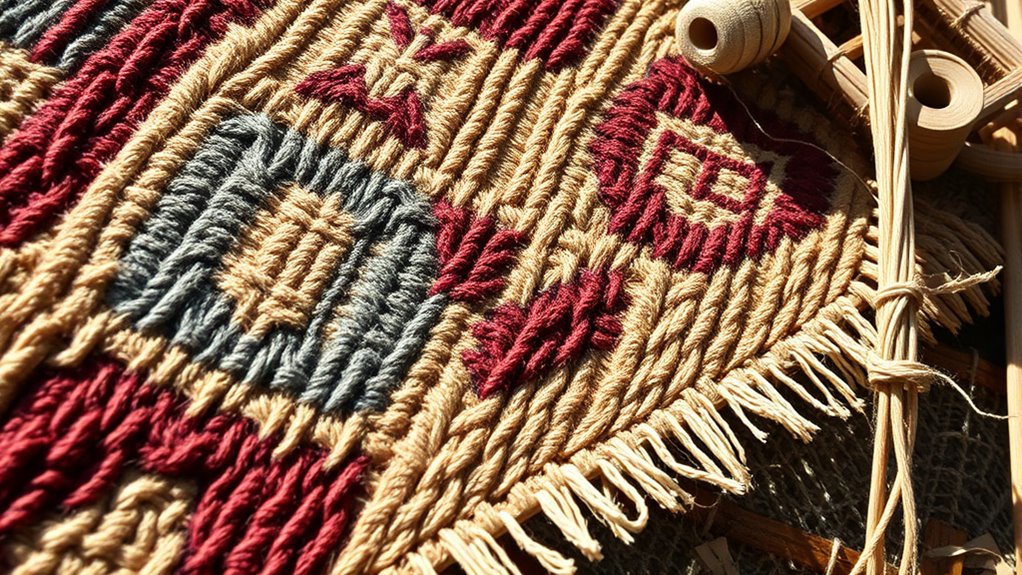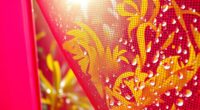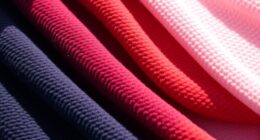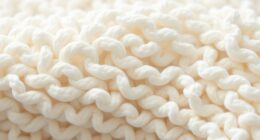Viking weaving techniques inspire today’s zero-waste patterns by emphasizing fiber preservation, careful craftsmanship, and meaningful designs. Their methods, like tablet and double weaving, create strong textiles with minimal waste, encouraging reuse and durability. Patterns often carried symbolic stories, reminding you to incorporate purpose and cultural significance into your work. By adopting their mindful approach, you’ll craft textiles that honor materials and tradition. Keep exploring to discover how these ancient practices can shape sustainable creations today.
Key Takeaways
- Viking weaving techniques like tablet and double weaving enabled complex, durable textiles with minimal waste through precision craftsmanship.
- Their fiber preservation and reuse practices demonstrate sustainable approaches to maximizing material utility.
- Pattern symbolism conveyed cultural stories and protective symbols, inspiring meaningful, culturally-rich designs today.
- Mending and reusing textiles reflect a resourceful mindset aligned with modern zero-waste and circular economy principles.
- Viking emphasis on fiber longevity and craftsmanship showcases sustainable practices that modern designers can emulate.

Viking weaving techniques reveal the skill and ingenuity of ancient artisans who transformed raw fibers into intricate textiles. These techniques weren’t just about creating clothing or tapestries; they reflected a sophisticated understanding of fiber preservation and pattern symbolism. When you explore Viking textiles, you see how they carefully preserved fibers to guarantee durability, using natural dyes that stood the test of time. This focus on fiber preservation meant their garments and textiles could last for generations, a principle that resonates with today’s zero-waste movement. Instead of discarding worn-out fabrics, Vikings mended and reused their textiles, understanding the importance of maximizing every fiber. This approach encourages us to value the longevity of our materials and minimize waste, reminding us that sustainability isn’t a modern invention but a time-honored tradition.
Additionally, studies indicate that their use of exfoliation through techniques like controlled dyeing and patterning contributed to the longevity and vibrancy of their textiles over centuries. Pattern symbolism played a crucial role in Viking weaving, serving as a language of sorts. Each motif and design carried meaning—protective symbols, clan identifiers, or stories woven into the fabric. When you examine their textiles, you notice how patterns were deliberately chosen, often based on cultural or spiritual beliefs, making each piece a narrative as well as an object of utility. Today, this idea inspires designers to incorporate meaningful patterns into zero-waste textiles. Instead of random or purely aesthetic choices, you can embed symbols that tell stories or convey values, creating textiles that are both sustainable and rich in cultural significance.
The techniques Vikings used, such as tablet weaving or double weaving, allowed them to create complex, strong textiles without excess waste. These methods encouraged precision and craftsmanship, ensuring that every fiber had a purpose. If you adopt similar methods, you’ll find that using efficient, deliberate weaving techniques reduces offcuts and scraps, aligning with zero-waste principles. Furthermore, by understanding how Vikings selected fibers and maintained their textiles, you gain insights into creating more durable, long-lasting items that don’t need frequent replacement.
In essence, Viking weaving techniques teach you the importance of thoughtful fiber use and meaningful design. They demonstrate that craftsmanship, respect for materials, and cultural storytelling can go hand in hand with sustainability. By studying their methods and values, you’re inspired to craft textiles that honor the past’s wisdom while promoting a more sustainable future. Their legacy reminds us that careful, intentional weaving isn’t just an art form but a blueprint for reducing waste and creating enduring, meaningful textiles today.
Frequently Asked Questions
How Do Viking Weaving Patterns Influence Modern Sustainable Fashion?
Viking weaving patterns influence modern sustainable fashion by inspiring designs rooted in ancient textile symbolism and natural Viking dye sources. You can incorporate these traditional methods to create zero-waste patterns that honor history while minimizing waste. By studying Viking techniques, you learn to optimize fabric use and embrace eco-friendly dyes, promoting a circular approach. This connection encourages you to craft garments that are both culturally meaningful and environmentally responsible.
What Materials Did Vikings Primarily Use in Their Weaving Techniques?
You learn that Vikings primarily used natural fibers like wool, flax, and hemp for their weaving techniques, which were abundant in their environment. They also relied on natural dye sources such as madder, indigo, and oak galls to color their textiles. These materials reflect their resourcefulness and sustainable practices, inspiring modern zero-waste patterns by emphasizing the use of eco-friendly fibers and dyes that minimize environmental impact.
Can Viking Weaving Methods Be Adapted for Mass Production?
Imagine turning back time to a world of intricate craftsmanship—Viking weaving methods can subtly influence modern practices. While their techniques are rooted in historical manufacturing, adapting them for artisan scalability remains feasible. You might find that blending traditional methods with contemporary tools allows for sustainable, small-batch production. This approach promotes craftsmanship while respecting resourcefulness, inspiring a zero-waste mindset that honors history without sacrificing efficiency for mass production.
Are There Preserved Viking Textiles Available for Study Today?
You’ll be interested to know that Viking textile preservation has allowed researchers to study ancient weaving artifacts extensively. While complete textiles are rare, preserved fragments and tools provide valuable insights into their techniques. These ancient weaving artifacts reveal intricate methods that can inspire modern zero-waste patterns. By analyzing these preserved textiles, you can better understand the craftsmanship and innovative approaches Vikings used, informing sustainable design practices today.
How Do Viking Weaving Tools Compare to Contemporary Weaving Equipment?
Imagine stepping into a time machine—Viking weaving tools are like ancient artisans’ brushstrokes, showcasing remarkable craftsmanship. Compared to modern equipment, Viking tools are simpler yet ingeniously crafted for durability. They reflect an early stage in the weaving process evolution, emphasizing manual skill over mechanization. Today’s weaving tools, with their advanced technology, build on that foundation, but Viking tools remind us how resourcefulness shaped textile history and inspire sustainable practices.
Conclusion
Just as Viking weavers spun their threads into resilient tapestries that told stories across generations, you too can weave sustainable patterns into your life. Imagine each eco-friendly choice as a strand, adding strength and beauty to a future where waste no longer dominates. By embracing these ancient techniques, you become the craftsman of a new, zero-waste world—where every action is a stitch in the fabric of tomorrow’s resilient, mindful society.









